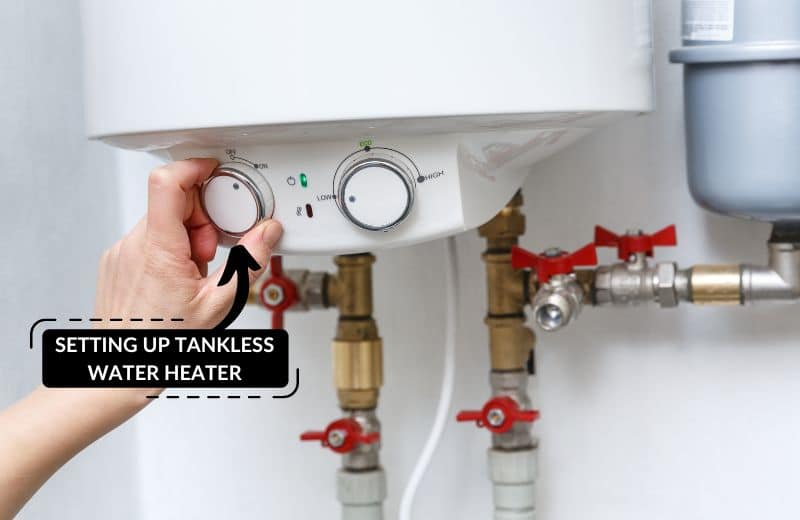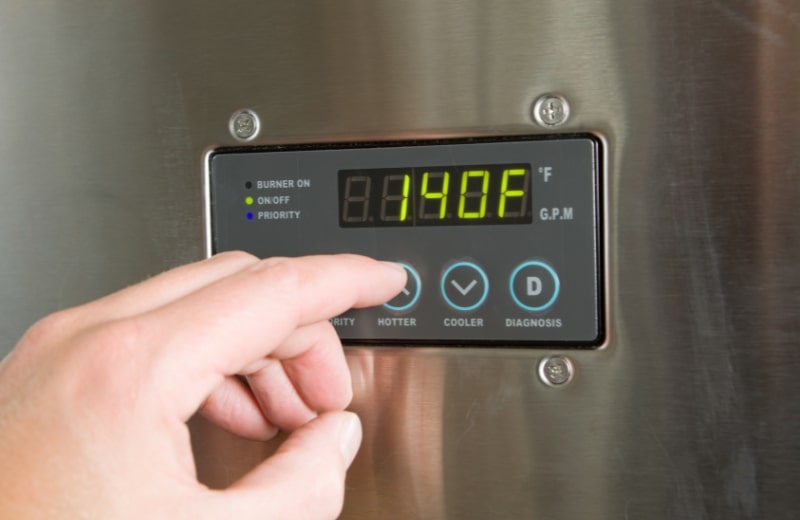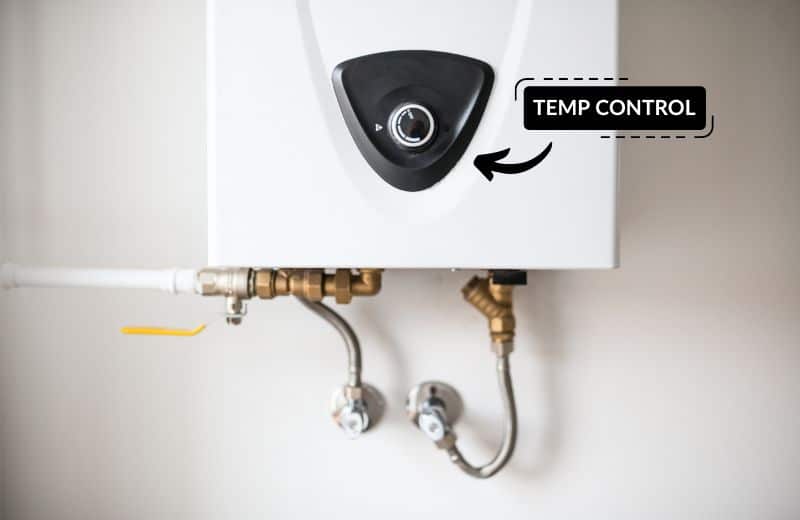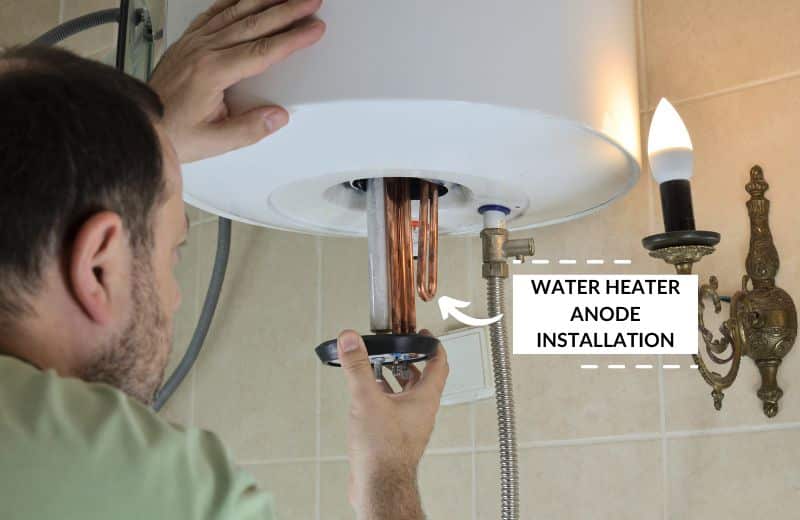Looking to install a tankless water heater in your home? Choosing the right size tankless unit is essential to make sure you get the right volume of hot water for your water demands.
In this guide, we’ve shared how to size a tankless water heater based on your required temperature rise and flow rate.
We’ve also provided a handy calculator that you can use to work out your ideal tankless water heater size in a matter of seconds.
📌 Key Takeaways:
- Sizing a tankless water properly is essential to ensure you get enough hot water even at times of peak demand.
- To properly size a tankless water heater, you need to know your required volume of hot water (in gallons per minute) and your required temperature rise.
- You can then go out and look for a tankless water heater that meets these specifications.
Table of Contents
- 🤔 How Do You Choose The Right Water Heater Size?
- 📐 How To Size A Tankless Water Heater: Step-By-Step
- 📲 Tankless Water Heater Size Calculator
- 🏠 Tankless Water Heater Size For Different Family Sizes
- 🧐 Why Is Sizing A Tankless Water Heater Important?
- 🆚 Sizing A Gas Vs Electric Tankless Water Heater
- 📋 Other Factors To Consider Alongside Tankless Water Heater Size
- 🕵️♂️ So, What Size Tankless Water Heater Do I Need?
- 💯 Our Top Tankless Water Heater Recommendations
- ❔ FAQs
🤔 How Do You Choose The Right Water Heater Size?
To choose the right water heater size, you need to know two things:
- The amount of hot water that you use during peak use. This is measured in gallons per minute, or GPM for short.
- The temperature rise required for a heater. That’s the increase in temperature from your incoming water temperature to your desired hot water temperature.
Once you know these things, you can check the manufacturer’s information for the water heater you’re interested in and buy the right-sized model for your needs.
Most manufacturers offer at least 4 different model sizes to choose from, making it easy for customers to tailor their purchase to their needs.

📐 How To Size A Tankless Water Heater: Step-By-Step
Follow these steps to correctly size a tankless water heater for your hot water needs.
Step 1: Determine Your Required Temperature Rise
First, work out the temperature rise required for your tankless water heater.
Temperature rise is the temperature difference between the incoming water temperature and the desired hot water temperature.
It’s easy to work it out using this formula:
Temperature Rise = Desired output water temperature – feed water temperature
How do you work out your feed water temperature? The quickest and most accurate method is to use a thermometer to take a temperature reading of the water from your cold water faucet.
Keep in mind that the time of the year, your local climate, and your water pipe material and insulation, will determine the temperature of your water.
If you live in a region that has very cold winters, your feed water will probably be colder in December through March compared to in the summer months. Google search: “Average groundwater temperature“ followed by your state or city to learn about the temperature range in your region throughout the seasons.
What’s a normal groundwater temperature? As we said, this depends on your location. Parts of Minnesota, Alaska, and Wisconsin will have an incoming water temperature of as low as 35 °F-40 °F, while warmer southern climates will have a milder incoming water temperature of up to 75 °F-80 °F.

Let’s say your incoming water temperature is 50 °F and you want to achieve an output temperature of 110 °F (about normal for showering, bathing, washing dishes, etc.).
You’d work out the temperature rise with the following sum:
110 °F – 50 °F = 60 °F
So, you’d need a water heater that was capable of increasing your incoming water temperature by 60 °F.
Note that you don’t need to aim for a higher output temperature than 110°F in most cases. There’s no point in making your heater work harder than necessary to produce water that’s too hot for showering and bathing, only to have to mix this water with your cold water at the fixture.
Related: How long does a water heater take to heat up?
Step 2: Determine Your Required Flow Rate
Next, work out your hot water demand at peak usage.
Below, we’ve shared a chart that lists the water fixtures in your home that use hot water, and the average flow rate of these fixtures in GPM (gallons per minute).
Count up all the hot water fixtures in your home, then use this chart to work out your average required flow rate when all these fixtures are in use.
| Water Fixture | Average Flow Rate (GPM) |
|---|---|
| Bathroom faucet | 1.5-2.2 |
| Kitchen faucet | 2.2 |
| Bathtub faucet | 3.0-4.0 |
| Shower head | 2.0-2.5 |
| Washing machine | 3.0-5.0 |
| Dishwasher | 2.0-4.0 |
The above flow rates are the average for these fixtures, and your own home’s plumbing fixtures might be different. The age of your fixtures and appliances, whether or not your fixtures are water-saving, and the size and location of the fixtures will determine their flow rates.
Also note that the listed flow rates indicate hot and cold water output, so the fixture’s actual hot water demand is likely to be a little lower. For instance, a washing machine will probably mix hot and cold water while it’s running, so the amount of hot water supplied to the appliance might only be 40-60% of its total water use, depending on your washing temperature setting.

This is especially the case for washing machines and dishwashers, which are difficult to give an estimated flow for. We recommend running one appliance and making a note of the reading on your water heater while it’s operating. This should give you a more specific flow rate for the appliance in question.
Let’s say you imagine you might run three appliances: a shower (with a 2.5 GPM flow rate), a washing machine (with a 4.0 GPM flow rate), and a kitchen faucet (with a 2.2 GPM flow rate) all at the same time during times of peak water use.
You could work out your required flow rate by doing the following sum:
2.5 GPM + 4.0 GPM + 2.2 GPM = 8.7 GPM
So, you would need a tankless water heater with a flow rate of at least 8.7 GPM to provide you with a suitable flow of water when all these water fixtures are in use at once.
Don’t want to guess at your water flow rates? There’s a more scientific method that should help you to get a more accurate reading of the flow of water from your fixtures (showers, faucets, etc.).
Just place a 1-gallon bucket underneath the fixture and switch it on. Track the time it takes for the bucket to fill completely. Then calculate the flow rate using this formula:

60 /Time taken to fill the bucket (in seconds) = flow rate
Or, if you have a smaller space beneath the fixture that won’t fill a 1-gallon bucket, you could use a similar formula and fill a one-quart bucket:
15 / Seconds taken to fill one-quart bucket = flow rate
Obviously, this test can only be used for water fixtures, and not appliances like dishwashers and washing machines.
Top Tips For Determining Tankless Water Heater Flow Rate
Here are a few of our top tips for choosing the right flow rate for your tankless water heater:
- Consider how you can reduce your peak hot water demand. If you want to save money on a tankless water heater and buy a slightly smaller model, consider some of the ways you can reduce your hot water demand during peak times. For instance, run your appliances when you don’t plan to shower or use hot water in your faucets, and take it in turns to have showers. That means you won’t have to buy a heater that’s large enough for, say, two people to shower and your washing machine to run concurrently at 8AM, but only has to provide hot water for one fixture at a time throughout the rest of the day.
- Account for your family size and your home size. You don’t necessarily need to buy a tankless water heater that’s big enough to supply hot water to 4 bathrooms in your home if there are only two people in your household.
- Also consider how many fixtures your heater will actually serve. Some people install tankless water heaters solely for a single bathroom or shower, while others are looking for a whole-home solution.
Step 3: Choose Tankless Water Heater Size
Now you have this information, you can go ahead and start shopping for a tankless water heater with the right flow rate and the desired temperature rise for your water demands.
All tankless water heater manufacturers should share a sizing chart for their products. These charts should specify the heater’s maximum flow rate based on the input water temperature and the desired temperature of the output water.
Here’s an example size chart for a tankless water heater:

Choose a unit that, at the very least, meets your hot water demand. It’s best to slightly oversize the unit so that it slightly exceeds your expected hot water demand. That way, you’re covered if you miscalculated your water usage or if you plan to expand your home or family in the future.
Be aware of exaggeration! Manufacturers will always show you the best-case scenario, which is another reason to slightly oversize your tankless heater choice to avoid disappointment.
📲 Tankless Water Heater Size Calculator
We’ve made it quick and easy to find out what size tankless water heater you need with this tankless heater size calculator.
Just input the number of each of the listed hot water fixtures you have in your home, and your groundwater and output water temperatures. This will tell you your required flow rate and water temperature rise.
🏠 Tankless Water Heater Size For Different Family Sizes
What size tankless water heater do you need if you have a family of 2, 3, 4, 5, or 6?
We’ve shared the average tankless water heater sizes for different family sizes below.
| Household Size | Flow Rate |
|---|---|
| Family of 2 | 6-8 GPM |
| Family of 3 | 7-9 GPM |
| Family of 4 | 8-10 GPM |
| Family of 5 | 9-11 GPM |
| Family of 6 | 11+ GPM |
The more people in your family, the more water, on average, you’ll use. You’re more likely to run several appliances and fixtures simultaneously, so you’ll need a larger tankless water heater that produces a bigger volume of water to meet your peak water demand at any given time.
Take this advice with a pinch of salt. Regardless of your family size, the number of hot water fixtures in your home, and the flow rates of these fixtures, is the biggest determiner of the required flow rate for your tankless water heater. Your inlet water temperature will also affect the heater size you need, so don’t only consider your family size when browsing your options.
🧐 Why Is Sizing A Tankless Water Heater Important?
Choosing the right sized tankless water heater is essential if you want to enjoy hot water on demand whenever you turn on a faucet or appliance – regardless of how many water fixtures you’re using at the time.
Remember that tankless water heaters deliver hot water on demand. They’re not like tank-based water heaters, which store a batch of hot water in a tank in preparation for whenever you need it.
Tankless heaters heat water and deliver it to the desired point(s) of use only when there’s a need for hot water in your plumbing system, so it’s important to buy the right-sized unit to make sure you don’t have to wait around for hot water and you get a continuous hot water supply at any time of the day.
Under-sizing a tankless water means that:
- The flow of hot water out of your faucets will decrease
- The volume of hot water production will be insufficient to supply your home during times of peak demand
- The temperature of your water may also be insufficient
If your water heater consistently works to the max, it’s more likely to break down before the end of its expected lifespan, resulting in expensive repairs or a complete replacement.
Is it possible to oversize a tankless water heater?
Yes, but oversizing doesn’t have the same consequences. It just means you’ve paid more for a heater that you don’t get full use of – but it could prove to be useful if you plan on expanding your home later.

🆚 Sizing A Gas Vs Electric Tankless Water Heater
Sizing a tankless gas water heater is exactly the same as sizing an electric tankless water heater.
You will still need to size the heater based on your required temperature rise and water flow rate, regardless of whether gas or electricity is used to heat the water.
However, you should be aware that the method of water heating determines its power, and the GPM produced at a particular temperature rise.
Gas tankless water heater units are more powerful than tankless electric water heater units, so they produce a faster flow of water compared to electric models at an equal required temperature rise.
You might notice that a manufacturer specifies the power required in BTUs (for gas tankless heaters) or KWs (for electric tankless heaters) to heat water based on the input water temperature and the desired temperature of the output water.
Ideally, the manufacturer will also have a column or a section for flow rate in their specs, so you can compare BTUs and KWs to the corresponding flow rate.
If not, contact the manufacturer to ask to see flow rate information.
📋 Other Factors To Consider Alongside Tankless Water Heater Size
Size is one of the most, if not the most, important factor when choosing a tankless water heater for your home.
But there are a few other factors that you should also consider when you’re deciding on the best tankless water heater for your needs.
These include:
Cost
Cost is a major factor to consider and is closely tied to water heater size.
On average, the average cost of a tankless water heater is $2,500-$3,500, excluding installation costs.
The bigger and more powerful the heater, the costlier it’ll be. So, if you need a large tankless water heater for a big home, it’ll set you back more because you’re paying for the extra parts.
The heater type will also affect its cost. Gas tankless water heaters are more expensive upfront than electric models because they have a more complex design and require a lengthier install, but they’re often cheaper to run in the long run because they’re more powerful and efficient.
| System Size | Cost |
|---|---|
| Whole-home | $400–$2,000 |
| Point-of-use | $180–$500 |
| 1–2 GPM | $180–$250 |
| 2–3 GPM | $250–$600 |
| 3–4 GPM | $330–$700 |
| 5–6 GPM | $450–$1,200 |
| 7–8 GPM | $530–$1,500 |
| >8 GPM | $650–$2,000 |
Gas Vs Electric
Also consider whether you prefer gas or electric tankless water heaters.
A tankless gas water heater is more expensive and requires a more complex initial installation, but it produces hot water faster than an electric water heater because of its efficient heating process.
Electric tankless water heaters are smaller and more compact than tankless gas water heater units, and they don’t need to be vented, but they have slower flow rates and only work when they have access to electricity.
Neither one of these heater types is better than the other, but one might be better for your situation.
Installation & Maintenance
Finally, consider the installation and maintenance involved in owning a tankless water heater.
You’ll have to hire a professional to install your water heater. Professional installation costs anything from $150 to $1,500, depending on the level of work required. Make sure you factor in the cost of installation before investing in a new water heater.
Like a tank water heater, a tankless water heater needs regular servicing. Most professionals recommend a once-year service that involves flushing out the heater and cleaning the filter.
Proper maintenance will keep your heater working as it should and prevent a drop in flow rate, so it’s an essential and unavoidable aspect of owning a tankless water heater.

🕵️♂️ So, What Size Tankless Water Heater Do I Need?
Now, you should have all the information you need to work out the right size tankless water heater for your hot water demand.
What are the likely sizes you will come across when you’re shopping?
- Smaller tankless water heaters with a 6-7 GPM flow rate are a good choice for homes with 1 bathroom.
- Mid-sized heaters with an 8–9 GPM flow rate are the most popular choice and are suitable for homes with 2 bathrooms.
- You should also find 9-11 GPM tankless water heaters that are suitable for homes with 3+ bathrooms.
Regardless of what size tankless water heater you choose, make sure the heater is sold by a reputable manufacturer and has plenty of positive customer feedback that supports the company’s performance claims.
Tankless water heaters are a big upfront investment. Make sure to follow out guidelines for proper sizing to enjoy continuous hot water from your heater at any time of the day.
💯 Our Top Tankless Water Heater Recommendations
Some of our top recommendations for the best tankless water heaters are:
- The Stiebel Eltron Tempra: The best electric tankless water heater
- The Rinnai RU199iN: The best gas tankless water heater
- The Rheem RTEX-13: The best point-of-use and budget tankless water heater
👨🔧 You can read our reviews of these tankless water heaters and our other top recommended products in our guide to the best tankless water heaters.
| Product |  Stiebel Eltron Tempra |  Rinnai RU199iN |  Rheem RTEX-13 |
|---|---|---|---|
| Power Type | Electric | Gas | Electric |
| Ratings | 5/5 | 4.5/5 | 4/5 |
| Price | $$ | $$$ | $$ |
| Flow Rate (GPM) | 3-8 | 11 | 3.17 |
| Max Temperature | 140°F | 140°F | 140°F |
❔ FAQs
How do I know what size tankless water heater to get?
To know what size tankless water heater you need, you need to know your peak flow rate requirements (in gallons per minute) and your desired water temperature rise (from the inlet water temperature to the desired output temperature). You can then choose a heater that has a GPM flow rate that’s sufficient for the water temperature rise you need.
What size tankless water heater do I need for a family of 4?
The average family of 4 needs a tankless water heater with a flow rate of around 8-10 GPM. The exact size of the heater you need depends on the number of bathrooms and hot water fixtures in your home.
What size tankless water heater do I need to replace a 40 gallon water heater?
To replace a tank water heater with a 40-gallon tank, we recommend installing a tankless water heater with 7 GPM to 10 GPM tankless heater.
How many tankless water heaters you need?
In most homes, you only need a single tankless water heater, even if you want to use the heater to supply hot water to all your fixtures. It’s cheaper and more efficient to buy one correctly-sized tankless heater instead of multiple smaller heaters for various use points in your home. However, if you have a mansion, even the largest 11-GPM tankless water heater will be too small to deliver enough water during peak hot water demand. In this case, you might need two heaters – we recommend combining the biggest gas tankless heater with a smaller electric unit.
Should you oversize a tankless water heater?
It’s a good idea to slightly oversize a tankless water heater to make completely sure that your heater will meet your hot water demands during times of peak use. Your family might grow over the years after the heater installation, increasing your water demands, and slightly oversizing a hot water heater means you can prepare for this likelihood. However, there’s no need to size your heater too big, since this will mean that the heater uses more energy than necessary.
How many GPM do I need for my house tankless water heater?
The GPM size of a tankless water heater for whole house use depends on how much flow is needed and your required water temperature rise. The average 2-bathroom home needs a tankless water heater with a 7-9 GPM flow rate. You can use our tankless hot water heater sizing calculator to work out the right water heater size for your home.
What size tankless water heater do I need for 2 showers?
Smaller electric tankless heaters with a flow rate of 6-7 GPM should be fine if you just want to provide hot water for 2 showers. If you need a tankless water heater for 2 showers and your home’s other appliances and hot water fixtures , the heater will need to be bigger – at least 7-9 GPM. The exact size of the heater depends on your household size and the number of hot water fixtures in your home.

